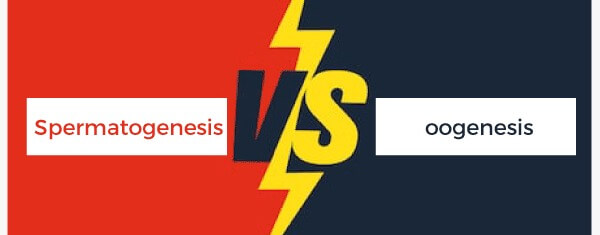Difference between Spermatogenesis and Oogenesis
Spermatogenesis and oogenesis are mitotic cell division processes that occur in the male and female, respectively. Spermatogenesis involves the production of sperms. Oogenesis is the production of eggs. Male gamete means sperm, and female gamete means ovum. The process that leads to the formation of gametes is called gametogenesis. The meaning of ‘Gameto’ is gamete, and the meaning of ‘Genesis’ is formation.
There are two types of gametes. One is male gamete (sperm) found in males, and another is ovum (female gamete) found in females. The formation of male gametes is known as Spermatogenesis, whereas, the formation of female gametes is called Oogenesis. Let us see how these processes differ from each other!

Spermatogenesis
Spermatogenesis, as its name indicates, it is the process of formation of sperms. ‘Spermato’ means sperm and genesis means formations. In spermatogenesis, the spermatogonia changes to primary spermatocytes. It is a continuous process that starts with puberty and continues till old age. So, it begins with the Spermatogonia, which is the diploid cell that undergoes mitosis to create two primary spermatocytes. This is the second step of Spermatogenesis.
Later, when meiosis occurs the primary spermatocyte divides into two secondary spermatocytes. As there are two primary spermatocytes, so there will be four secondary spermatocytes after meiosis. These spermatocytes change into spermatids which create four equal size sperm cells.
Spermatozoa (sperm cells) are minute, streamlined, motile, and yoke less. Motile means they can move because they have to penetrate the ovum. Being minute and streamlined they can easily swim and reach the egg or ova.
The steps involved in Spermatogenesis:
There are three steps involved in this process. In simple words, we can say Mugroma to this process. Mu means Multiplication, gro means growth, and ma means maturation.
1. Multiplication phase:
This is the first phase in which sperm mother cells or primordial sperm cells divide repeatedly through mitosis to produce a large number of diploid sperm mother cells, which are called Spermatogonia.
2. Growth phase:
Spermatogonium (plural: spermatogonia) collects more food and increases the size, so it is known as the growth phase. After increasing in size spermatogonium becomes the primary spermatocytes. Primary spermatocytes perform meiosis due to which chromosome numbers are reduced to half in secondary spermatocytes which are formed after meiosis.
3. Maturation phases
The cells which are made from meiosis are called secondary spermatocytes, which are haploid as they have half of the chromosomes. Secondary spermatocytes perform meiosis to produce the spermatids which are developed into sperm.
Oogenesis
It is a process of formation of the ovum. ‘Oo’ means eggs, and genesis means formations. Oogenesis starts prior to birth which means in the foetus before birth. In this process, the oogonia (germ cells) undergo mitosis to divide into two primary oocytes, but then the process is put on hold so a baby girl is born with all the primary oocytes you will ever have, and that’s why after a woman reaches certain age oogenesis stops as there are no more primary oocytes to initiate meiosis.
The production of the egg cell is reactivated when the girl hits puberty, and that is when stage one of meiosis occurs. Hormones are released into the body that activates primary oocytes to divide into secondary oocytes. The process is put on hold again. Meiosis too doesn’t begin until fertilization starts. This happens in meiosis one and two of oogenesis. The cytoplasm divides unequally to form one egg and smaller polar bodies. So one primary oocyte will produce one egg. This means one oogonium will produce a total of two egg cells in the end. Ova are larger, rounded in shape, and cannot move, so they are non-motile.
There are also three steps in oogenesis:
1. Multiplication phase:
The primordial cells perform mitosis and produce a large number of egg mother cells or oogonia.
2. Growth phase:
In this phase, oogonium (plural; oogonia) collects or accumulates more food and increases its size and develops into a large primary oocyte.
3. Maturation phases:
Primary oocytes undergo two meiotic divisions and are produced, which are haploid and matures into the ovum in the fallopian tube of the ovary.
Difference between Spermatogenesis and Oogenesis
| Spermatogenesis | Oogenesis |
|---|---|
| The process of formation of male gametes (sperm) is called Spermatogenesis. | The process of formation of female gametes (ovum) is known as oogenesis. |
| It occurs in the testis. | It occurs in the ovary. |
| Yolk synthesis does not occur. | Yolk synthesis occurs. |
| The growth phase is not differentiated into two parts. | The growth phase is differentiated into two parts that are pre and post vitellogenesis. |
| Maturation phases occur in testis. | Maturation phases occur outside the ovary. |
| The first and second maturation is done equally. | The first and second maturation is done unequally. |
| Daughter cells are equal. | Daughter cells are unequal. |
| Four sperms are produced. | One ova and three polar bodies are produced. |
| The growth phase is short. | The Growth phase is very long. It lasts from few days to many years. |
| Spermatocytes have cytoplasm and nucleus with normal content. | Oocytes have cytoplasm rich in RNA, ATP, enzymes, yolk, and nucleus. |
| Spermatogonia converts into primary spermatocytes. | Oogonia develop into the primary oocyte. |
